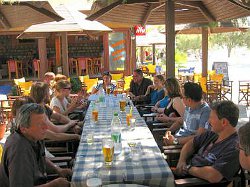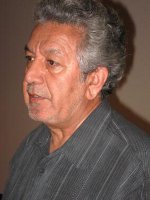Eco-Architecture 2012
4th International Conference on Harminisation between Architecture and Nature 2012
5 - 7 September 2012
Kos, Greece
Overview

The 4th International Conference on Harmonisation between Architecture and Nature was held in Kos, organised by the Wessex Institute of Technology of the UK. The meeting was sponsored by WIT Transactions on Ecology and the Environment and two international journals, ie Design and Nature and Ecodynamics, and Sustainable Development and Planning.
This successful series of conferences started 2006 in the New Forest, home of the Wessex Institute, and the meeting was subsequently held in the Algarve (2008) and La Coruña (2010).
The success of this conference is rooted in the need to optimise our natural resources and preserve the balance of nature. Eco-Architecture provides imaginative solutions to deal with those issues which are in harmony with nature. Its designs are based on ecological grounds concerning locations, siting and orientation of the buildings as well as providing well informed choice of materials.
Eco-Architectural solutions minimize the use of energy at each stage of the buildings life cycle from the stage of extraction and transportation of materials to their recycling at the end of the construction’s life. Energy conditions also need to be taken regarding maintenance, lighting, heating and cooling, and even possible changes in the building use. Substantial savings can be achieved by the intelligent choice of materials and passive energy systems. Renewable energy resources can provide heating and electric power.
The Conference provided an ideal forum for the discussion of different aspects of Eco-Architecture, which is by definition interdisciplinary and requires close collaboration between all stakeholders, attracting engineers, physicists, sociologists and economists as well as architects and planners.
Opening Address
The meeting was opened by its Chairman, Professor Carlos A Brebbia, Director of Wessex Institute of Technology, the organiser of the meeting.
Carlos referred to the importance of the conference series for WIT objectives, which are the dissemination of knowledge through different mechanisms. Conferences – Carlos said – are perhaps the most effective and important way of rapid communication of our results throughout the community. The meetings are the source of excellent papers for the Transactions of Wessex Institute and the best way in which scientists can establish contact with each other. Most of the international projects at WIT originated as results of contacts made at a scientific meeting. Furthermore extended versions of papers presented at the Conference are afterwards published in a WIT International Journal. In many cases the work of the scientists evolve into monographs or edited books that are also published by WIT Press. Conferences and similar meetings generate long term networks essential for the ongoing development of sciences and engineering.
Carlos then showed a few examples of the research work carried out at WIT and in particular that resulting from international consortia. WIT, Carlos explained, is always happy to interact with other groups around the world contributing the Institute expertise in computer solution of engineering and scientific problems.
Conference Topics

- Bioclimatic design
- Design with nature
- Building technologies
- Ecological and cultural sensitivities
- Case studies
- Ecological input of materials
- Vertical greenery systems
- Education and training
Keynote Address
The conference sessions were enhanced by the following keynote address:
‘Challenges of cost-effective high-performance residential construction on the U.S. Market: lesson learned from building Utah’s most energy efficient, cost-effective house’
by J Rügemer, Utah University, USA
Special Session
Professor Riccardo Pulselli of the University of Siena organised a special session on Vertical Greenery Systems consisting of his keynote address followed by two papers. The address was entitled:
‘A sustainability evaluation of vertical greenery systems based on energy’
by R Pulselli
The two associated papers were:
‘Vertical greening systems: Contribution on thermal behaviour on the building envelope and environmental sustainability’
by K Perini
‘Thermo-physical Performances of Living Walls via Field Measurements and Numerical Analysis’
by U Mazzali
Book Launch

A new book was launched during the conference entitled ‘Heritage and Sustainability in the Islamic Built Environment’ edited by Bashir Kazimee.
Bashir is Professor of Architecture at Washington State University since 1990. Bashir is a licensed architect and has taught architecture in Texas Tech, King Faisal University in Saudi Arabia as well as Kabul University in his native Afghanistan, where he originally graduated with a BSc in Architecture. He holds a Master of Architecture in Advanced Studies from MIT. He has produced more than 60 papers on traditional architecture and sustainable settlements. He is co-author of a book on ‘Place, Meaning and Form in the Architecture and Urban Structure of Islamic Cities’ published in 2003.
Bashir gained international reputation in the field of sustainability with his proposed plan entitled ‘Sustainable Development – A Comprehensible Urban Regenerative Proposal for Pullman, USA’ which was awarded the International Academy of Architecture United Nations Gold Medal in 1996.
Bashir as a licensed architect has practiced in several countries including Afghanistan and the USA.
His projects include the American University of Kabul, a University Sustainable village in Pullman, USA, the Pullman Sustainable urban design project; a Mosque in Lubbok, Texas, apartments and houses in Kabul amongst many others.
Wessex Institute of Technology is proud of having been associated with Bashir through his participation in a series of conference on sustainability in the built environment, including Eco-Architecture. He is a member of the Scientific Advisory Committee of a series of WIT conferences.
WIT Press, the publishing arm of our Institute, has published many of his papers and Bashir serves on the Editorial Board of the International Journal of Design & Nature and Ecodynamics.
The book launched - ‘Heritage and Sustainability in the Islamic Built Environment’ represents an important contribution to the understanding of Islamic culture.
We can all learn – Carlos said - important lessons from the harmonic relationship between Islamic architecture and its surrounding ecology. Their use of siting, ventilation, material selection and architectural forms - in many cases in extreme conditions - is unique.
Professor Bashir Kazimee then proceeded to present the main features of his book, which contains the following topics:
- Place and meaning in urban Isfahan
- Urban recovery: the case of historic Kabul
- Human scale and sustainability in the Ottoman mosque and külliye
- Tradition and continuity in the built environment: towards a housing model of Kandahar, Afghanistan
- Historic context strategy with implications to Islamic heritage environment
- The traditional Malay Melaka house of Malaysia: the architectural and cultural heritage
- Sustainable development and eco-tourism at Bamyan, Afghanistan
- Spatial heritage of sustainable urbanism in Yazd, Iran
- Iran built environment: a sustainable sample of Islamic cities
- Catching up with The Kite Runner: architectural authenticity in a world overrun by globalization
- Sustainable strategies for preservation of Moslem built environment with focus on arid regions
The book is available from WIT Press (witpress.com) ISBN:978-1-84564-624-0 & eISBN:978-1-84564-625-7
Carlos congratulated Bashir for his excellent work which has been well received amongst the international community.
Conference Dinner & Social Events

The menu included some local specialities and in particular the oven baked meats for which the restaurant is renowned. The food was accompanied by good local wines and the dinner ended with sweets and a glass of raki.
During the meal a group performed island dances and persuaded some of the most energetic delegates to join them, contributing to the enjoyment of the evening.
At the end of the conference the delegates were offered lunch at one of the nicest beaches on the island, where they had the opportunity to swim and sunbathe before returning to the hotel. The visit gave them occasion to cement their contacts in a relaxed environment.
Conference Proceedings
The proceedings of Eco-Architecture, 464pp (Print ISBN: 978-1-84564-614-1 eISBN: 978-1-84564-615-8) are available from WIT Press. Orders can be placed on the WIT Press web site at www.witpress.com or by email:Papers from the conference will also be hosted online at the WIT eLibrary as Volume 165 of WIT Transactions on Ecology and the Environment (ISSN: 1746-448X, Digital ISSN 1743-3541). For more details visit the WIT eLibrary at http://library.witpress.com
Associated Conference
A conference in an associated topic is Sustainable Development and Planning to be held in Kos, Greece from 27 - 29 May 2013 (see http://www.wessex.ac.uk/13-conferences/sustainable-development-and-planning-2013.html).


 Wessex Institute
Wessex Institute